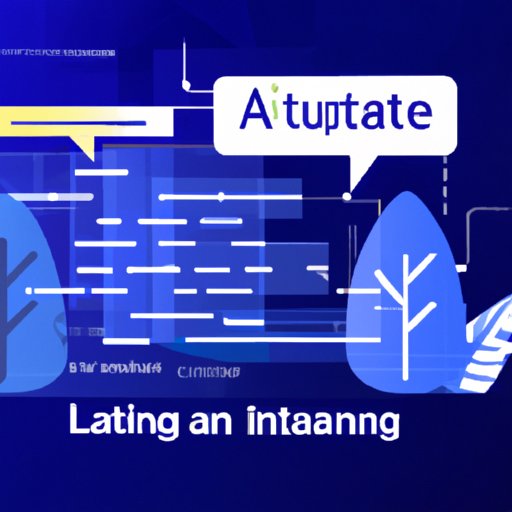Introduction
Natural language processing (NLP) is a branch of artificial intelligence (AI) that focuses on enabling computers to understand and process human language. Put simply, NLP is a type of machine learning technology that enables computers to interpret human language and respond accordingly. In other words, NLP is a way of making machines understand human language in the same way humans do.
NLP can be used to automate tasks such as text analysis, sentiment analysis, and voice recognition. It can also be used to build powerful AI applications such as virtual assistants, chatbots, and automated customer service systems. In this article, we’ll explore what NLP is, how it works, and its potential impact on AI.
What is Natural Language Processing in AI?
Natural language processing (NLP) is a type of artificial intelligence (AI) that enables computers to understand and process human language. NLP is used to analyze large volumes of text, speech, and audio data to extract meaningful insights from it. This process is known as “natural language understanding” (NLU). NLU involves using algorithms to interpret natural language and generate output that is meaningful to humans.
The goal of NLP is to make machines understand human language in the same way humans do. To accomplish this, NLP uses techniques such as natural language understanding, natural language generation, and natural language processing. These techniques allow computers to interpret natural language and generate a response that is meaningful to humans.
How Does it Work?
NLP relies on algorithms to interpret natural language and generate output that is meaningful to humans. The algorithms are trained using large amounts of data that is labeled with specific categories or classes. For example, if an algorithm is being trained to recognize positive and negative sentiment in a sentence, it will be presented with sentences labeled as either positive or negative. The algorithm then learns to identify the patterns in the data and make predictions about new data.
Once the algorithm is trained, it can be used to process new data and generate meaningful output. For example, if the algorithm is given a sentence, it can recognize whether the sentiment of the sentence is positive or negative. It can also be used to automatically generate responses to questions, or to identify relevant information in a text.
Overview of the Basics
In order to use NLP effectively, it’s important to understand the basics of how it works. At its core, NLP is a form of machine learning that uses algorithms to interpret natural language and generate meaningful output. This output can be used for a variety of purposes, including text analysis, sentiment analysis, and voice recognition.
NLP relies on a combination of natural language understanding, natural language generation, and natural language processing. Natural language understanding involves using algorithms to interpret natural language, while natural language generation involves using algorithms to generate output that is meaningful to humans. Finally, natural language processing involves using algorithms to process raw data and generate useful insights from it.

Exploring the Power of Natural Language Processing in AI
NLP has become increasingly popular due to its ability to enable machines to understand and process human language. This has opened up a number of possibilities for AI applications, including virtual assistants, chatbots, and automated customer service systems. NLP has also been used to create powerful AI applications such as facial recognition systems and automatic translation services.
Benefits of Natural Language Processing
One of the main benefits of NLP is its ability to automate tasks that would otherwise require manual effort. By automating these tasks, NLP can save time and money, while also increasing accuracy and efficiency. Additionally, NLP can help to reduce errors by automating processes such as text analysis and sentiment analysis. Finally, NLP can be used to generate meaningful insights from large amounts of data, which can be used to improve decision-making.
Role of Natural Language Processing in AI Applications
NLP plays an important role in many AI applications. For example, NLP can be used to build virtual assistants that can understand and respond to natural language queries. These virtual assistants can be used to provide customer service, answer questions, and even complete tasks such as booking appointments or ordering products. Additionally, NLP can be used to build chatbots that can have conversations with users and provide them with information.
NLP can also be used to build facial recognition systems that can identify people based on their facial features. Finally, NLP can be used to build automatic translation services that can translate text from one language to another. All of these applications rely on NLP to interpret natural language and generate meaningful output.
Understanding the Impact of Natural Language Processing in AI
NLP is revolutionizing the way we interact with technology. By enabling machines to understand and process natural language, NLP is opening up a world of possibilities for AI applications. From virtual assistants to facial recognition systems, NLP is changing the way we interact with technology.
Changing the Way We Interact with Technology
NLP is transforming the way we interact with technology. With NLP, machines can now understand and respond to natural language queries, allowing us to communicate with them in a more natural way. This has opened up a world of possibilities for AI applications, from virtual assistants to facial recognition systems.
NLP is also making it easier for machines to process large amounts of data. By automating tasks such as text analysis and sentiment analysis, NLP can help to generate meaningful insights from data that would otherwise be too difficult or time-consuming for humans to process.
Guide to Natural Language Processing in AI
NLP is a powerful tool that can be used to create powerful AI applications. To get started with NLP, it’s important to understand the basics of how it works. NLP relies on algorithms to interpret natural language and generate meaningful output. Additionally, NLP can be used to automate tasks such as text analysis, sentiment analysis, and voice recognition.
By understanding the basics of NLP, you can begin to explore its potential applications in AI. From virtual assistants to facial recognition systems, NLP can be used to create powerful AI applications that can help to improve our lives.
Conclusion
Natural language processing (NLP) is a powerful tool that is transforming the way we interact with technology. By enabling machines to understand and process human language, NLP is opening up a world of possibilities for AI applications. From virtual assistants to facial recognition systems, NLP is changing the way we interact with technology.
By understanding the basics of NLP, you can begin to explore its potential applications in AI. NLP can be used to automate tasks such as text analysis, sentiment analysis, and voice recognition, as well as to generate meaningful insights from large amounts of data. By leveraging the power of NLP, you can create powerful AI applications that can help to improve our lives.
(Note: Is this article not meeting your expectations? Do you have knowledge or insights to share? Unlock new opportunities and expand your reach by joining our authors team. Click Registration to join us and share your expertise with our readers.)
